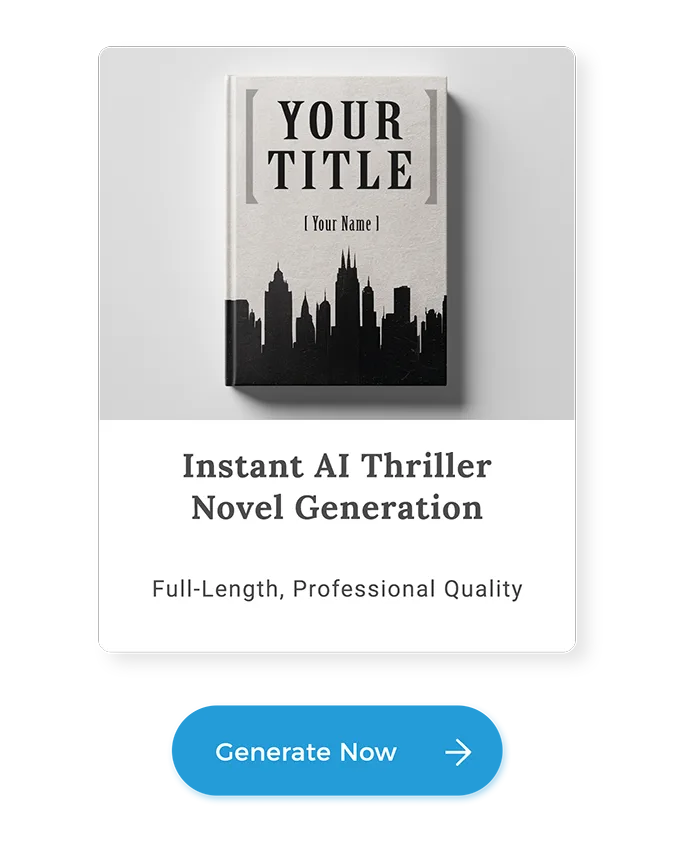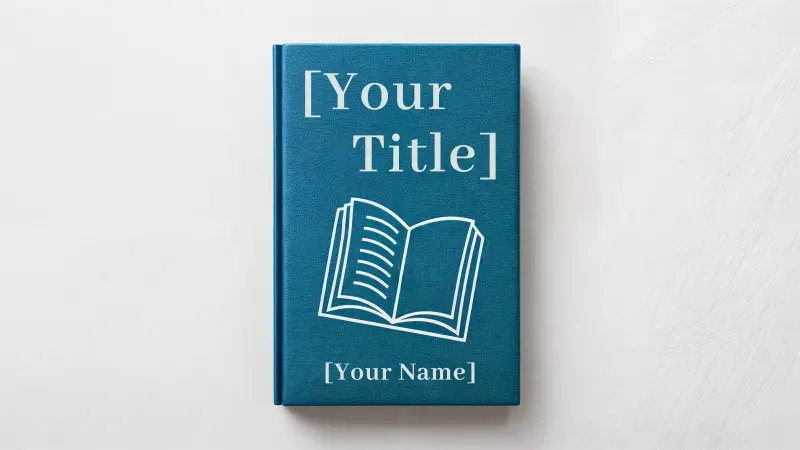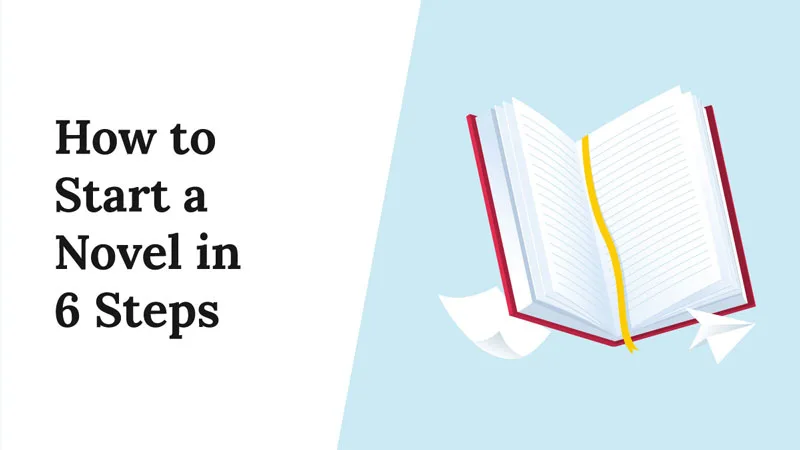How to write a thriller novel? Read the article to have the process at your fingertips.
Knowing how to write a thriller is the same as learning any genre. While any work of fiction allows for unlimited creativity and interpretation, there are still guidelines.
Every thriller genre has “rules” that when followed, create a perfectly structured story in the style you’re after.
This is not to say rules can’t be broken. But, when you’re just starting, it is smart to follow the basic genre conventions for writing thrillers.
How to Write a Thriller in 7 Steps
Everyone works a little differently, but if you follow these seven steps below, you can put together a classic, effective thriller.
1. Develop Characters
Even though a thriller is action-packed and plot-driven, character quality is still paramount to the success of your story.
The main characters in a thriller are as complex as the story itself. Not every type of person is cut out for what some thriller protagonists have to do, so you need to make sure you create the right type of character. They also must be believable. It is easy to create a perfect, easily lovable hero and a crazy, evil, sadistic villain with no feelings. But, this isn’t realistic and it won’t hold up.
Your characters must be balanced. Give your protagonist some flaws and make sure your antagonist has some sort of justification for what they’re doing – even if it’s only internal.
Each character must have a clear motivation that will logically drive the actions that they take throughout the story. If you’re still unsure, ask yourself a few questions to help determine the character’s motivation:
Why are they the way they are?
Who needs to be saved? Someone else, or the protagonist?
How do they react to negative situations or obstacles?
What do they want most out of life?
What is their main goal concerning the story?
The answer to these questions will provide you solid idea about your character profile. With Squibler’s AI-driven character development feature, crafting compelling characters becomes an effortless journey. With Squibler’s advanced algorithms, you can generate unique characters by suggesting nuanced personality traits, backgrounds, and even physical appearances. You can delve into a vast repository of character elements, selecting traits that resonate with their narrative vision. Squibler not only aids in creating distinctive characters but also provides detailed descriptions and visuals, ensuring that your protagonists and antagonists come to life on the pages of your novel.
2. Take Action
Regardless of genre, the opening scene is one of the most important. It’s what gives the reader their first impression of the story, and they will have one of three reactions:
Their attention will be grabbed immediately and they will be pulled right in. They will develop a deep desire to know what happens next, and they will keep reading without hesitation.
If the opening scene is weak but perhaps still interesting, they may decide to read on but remain skeptical until things pick up.
If the beginning of the story doesn’t interest them at all, they may stop reading right then and there. They’ll close the book with a sigh and momentarily mourn the money they now feel they wasted.
Number one is, of course, the ideal reaction. Number two is not great, but manageable as long as the rest of your story is enough to pique their interest. The last one is what we want to avoid at all costs.
When a reader picks up a certain book, they are generally aware of the genre they have chosen. They will have certain expectations. With a thriller, they want to be thrilled. They want excitement and wonder. This is why action is almost always the best way to start a thriller.
One of the most important things is to avoid dumping too much information. Don’t worry about background details, they can be revealed later. If you’re worried about confusing your reader – don’t! A tiny bit of confusion can work in your favor. It will make them want to read on to find the answers.
This is often achieved by placing a murder in the opening scene. This is common because it’s effective, but it’s not the only way to do it. Feel free to be creative, just make sure you go big enough. Whatever you choose to do, you need to create a sequence that starts your protagonist moving forward right away.
With Squibler’s “Generate Scene” tool, you can integrate adrenaline-pumping elements into your narratives. Squibler transforms ideas into vivid and engaging sequences when you provide the key elements of a scene. You can maintain the flow and intensity with the Smart Writer, and craft paragraphs that maintain the tone and direction of the various action sequences that will compel the reader to the novel.
3. Raise the Stakes
Once you’ve taken care of the initial action, it’s time to show your readers exactly how high the stakes are for your protagonist. High stakes add to the tension, drama, and anticipation. It helps your readers become invested in your protagonist because they want to see them succeed against all odds.
You can create high stakes out of several different things:
The very life of the protagonist or someone they love can be at stake.
There can be a significant amount of money at stake.
You can put the fate of a country at stake (the government might be taken over by corruption).
Life-threatening and/or life-saving secrets or information can be at stake.
You can create stakes out of anything like this that is big, important, and/or life-altering in a major way. Stakes can be extremely personal and remain within the family. Or, they can be as broad as an entire country.
The stakes you choose will depend on the type of story you are writing as well as the protagonists themselves. They just need to be big enough for your readers to become invested.
With Squibler’s “Generate Scene” feature, you can seamlessly introduce high-stakes elements by selecting crucial plot points and describing their significance. The Smart Writer will develop the plot for you in a way that the escalation of stakes is seamlessly integrated into your storyline, maintaining reader engagement as they become deeply invested in the protagonist’s journey against formidable odds.
4. Create Obstacles
Excitement is a huge part of a thriller. No story would be interesting if everything was easy for the protagonist. This is why you need to create challenges.
You also need to continue making your readers care about your character and what happens to them. This can be done by placing them in impossible situations. When your reader can’t tell whether or not your character will be getting out alive, this increases the stakes and the anticipation.
Within these challenges and difficulties, you’ll find your midpoint. In a thriller, this is usually either a false high or a false low. Your protagonist either appears to win/make significant progress or fail.
Either way, it ends up turning around. This event or series of events will give them some more insight into what the antagonist wants and why. This helps push them from a reactive state into a more proactive one.
The obstacles and challenges will make the ultimate victory even sweeter for both your protagonist and the readers.
Use Squibler to craft obstacles that will elevate the excitement in your thriller. With its “Smart Writer”, you can seamlessly introduce challenging scenarios, placing protagonists in impossible situations that keep readers on the edge of their seats. Squibler will generate the storyline in a way that will maintain a delicate balance between false highs and false lows at the midpoint. By orchestrating events that provide insights into the antagonist’s motives, Squibler propels protagonists from a reactive to a proactive state, and this way you can add more depth to the narrative.
5. The Plot Twists
Next, it’s time to start creating your plot twists. High stakes and obstacles are just the beginning. No thriller is complete without a proper set of plot twists.
When people hear “plot twist,” many think of a big, dramatic surprise ending that no one sees coming until it’s already there. These twist endings are often a fantastic way to end a story – especially a thriller.
But, a gripping thriller needs more than just one big reveal. The entire story should be peppered with unexpected events and fast-paced twists and turns in the action.
Be careful and attentive when writing in your twists. It can be easy to let plot twists become plot holes. This is where goodwriting software can come in handy. Something likeSquibler can be abundantly helpful in staying on track and keeping your thoughts organized.
Squibler helps you outline, research, and write your novel all in the same place. It gives you a place to take notes and jot down ideas right next to a chapter or scene in front of your eyes. Not only will this help you avoid plot holes by keeping everything straight, but it’ll get your book done faster and more efficiently in general.
With Squibler’s organizational capabilities, including note-taking and idea jotting alongside chapters and scenes, you can effortlessly foreshadow twists, ensuring they are subtle yet impactful.
In addition to staying organized, you need to make sure each twist is big enough. It needs to change things. It needs to keep things moving forward, otherwise, it will feel useless and boring to the reader. Keep these things in mind to create the best possible plot twists:
Make sure the twist is both necessary and plausible.
Even if it’s surprising, make sure it will make sense to the reader.
Use a double plot twist. Write a smaller, less significant twist right before revealing the actual plot twist which blows their mind in a big way.
Don’t stop the action right after the twist is revealed. If anything, use it to amp up the tension and drama.
Foreshadow the twist beforehand. But make it
subtle.
Redirect your reader’s suspicion. Try to determine what they will be expecting to happen, and don’t let that happen. Distract them from the result with the action and/or emotion of another scene or situation.
Always aim to deepen and enrich the story. Don’t simply twist the plot for shock value and nothing else.
Successful plot twists don’t always come easy, but they do always pay off.
Crafting compelling plot twists is a seamless endeavor with Squibler’s features.
With Squibler’s smart technology, you can weave unexpected events seamlessly into the narrative. Squibler’s AI assistance ensures that each twist is both necessary and plausible, steering clear of potential plot holes. You can also maintain the pacing and tension after a twist, amplifying the drama rather than halting the action.
6. The Climax
As you near the end of your story, you’ll need to start bringing your characters into alignment for the climax. The climax is one of the most crucial points in the whole story. It is where your protagonist and antagonist have their showdown and the ultimate victor is decided.
Will your protagonist and their team receive their justice? Or will the bad guy win and create a new world order?
As your protagonist nears this showdown, give them little bits of success. This builds their confidence and paves the way for them to ultimately defeat (or lose to) the antagonist in the final battle.
This final sequence doesn’t have to be an actual battle. It can be a battle of wits or a test of will. They can race to see who can outsmart the other faster. It can be a psychological thriller showdown where only words are spoken.
Whatever it is, don’t neglect it. It decides the ending of your story and thus, the fate of your protagonist and those surrounding them. Some find it helpful to write the climax before anything else. This allows them to know what they’re working towards when writing the rest of the story.
With Squibler, you can seamlessly align characters, setting the stage for the ultimate showdown between the protagonist and antagonist. With the Smart Writer, you can chase scenes that can build the protagonist’s confidence by strategically incorporating little bits of success, laying the foundation for the final battle. Moreover, you can plan and write the climax early to have a clear roadmap for the rest of the story, ultimately influencing the fate of the protagonist and those intertwined in their journey.
7. The Ending
When all’s been said and done and the climax is over, your readers want an ending that leaves them satisfied.
Don’t let yourself confuse satisfied with happy. A happy ending isn’t necessary. Sometimes, the villain wins. You can still satisfy your readers without the happiest of endings.
Two vital things must occur for the ending to be complete. First, you need to tie up all loose ends and unanswered questions. Unless, of course, you are purposely leaving things open-ended and up for interpretation. But, don’t do this by accident.
Another exception is if you are planning to write a sequel or series of books that follow this one. In this case, unanswered questions and cliffhangers are good. This will keep readers coming back and buying the subsequent installments.
Secondly, you need to depict, however briefly, what the world looks like now. What has changed for your protagonist? What is their life like now? Are things better or worse than before? How have they changed and what have they learned?
Once you have accomplished these things, your story will end with a satisfying conclusion.
Thriller Novel
Writing a book is not an easy task, so writing thrillers specifically can be a process. I’ve laid out the steps for you, but that doesn’t guarantee success. It’s up to you to put the steps into action and turn it into an action-packed masterpiece.
I already touched on the dangers of being unorganized while writing thrillers. Especially with thrillers, keeping track of those plot twists, complex characters, and ever-rising stakes can be tough. Plot holes are a killer and you’re better off preventing them than trying to fix them.
This is why writing with good software is important. In addition to this, it is helpful to use a good thriller novel writing prompt.
Squibler’s goal is to help you write your novel in 30 days – not by rushing but by enhancing productivity with the Smart Writer and staying organized.
If you are looking to get started right away, then generate a thriller novel with AI:

Thriller vs. Mystery and Horror: What is it?
When learning how to write a thriller, you’re looking at lots of action, suspense, high stakes, and a ton of conflict. Thrillers are largely plot-driven and a little bit less focused on character – though development is still important.
You want every single scene in a thriller to move the story forward. Everything should be advancing the plot. Thrillers are no place for fluff or filler. Perhaps some brief comic relief, but that’s it.
This ensures that the pace never slows. If your thriller slows down too much, you’ll lose the interest of your readers. They are there to be thrilled, after all.
Thriller vs. Mystery
Many tend to get thrillers and mystery novels mixed up or think they are the same thing. It’s an easy mistake – after all, mysteries are pretty thrilling, aren’t they?
They are, but several key differences separate these two similar yet different types of thriller stories.
The main separating force is the drive. The action in the story is driven by different things.
In a mystery, the story is moved forward mostly by the protagonists themselves. This will be a sleuth or detective who is following the case, uncovering clues, and going after the answers. Their actions will keep the pace of the story. The central crime is almost always murder and the serial killer is not discovered until the end.
In a thriller, the action is driven primarily by things the protagonist cannot control. Outside circumstances and the decisions of others will play a much bigger role. Most of the time, your protagonist will only be able to react to these things, rather than dictate how they go. There doesn’t necessarily have to be a murder. Whatever the crime or evil is, the perpetrator is often known. The point of the story is not the discovery of their identity, but rather to take them down.
In each crime thriller, you will be after clues, answers, and a proper solution. But, how each protagonist ends up where they do – the circumstances they find themselves in – are different.
Lastly, a mystery may place more importance on the surprise and tension within the story whereas a good thriller can be all physical action.
Thriller vs. Horror
Another common misconception is that horror and thriller are the same and can be used interchangeably. While they are similar, they are not the same, either.
Both are intense and can be freaky, but there are some distinctions:
A thriller is, by definition, meant to thrill. What happens in a thriller will excite audiences and create a great deal of suspense and tension. The storyline and characters are more complex and psychological. You usually have to think your way through a thriller to follow what happens.
A horror, on the other hand, is meant to horrify. A horror story will contain much more grotesque and detailed instances of gore, death, and violence. It will create disturbing visuals. It bypasses excitement and anticipation and goes right for fear. Horror doesn’t want to entertain you. It wants to terrify you. Horror won’t have as much focus on character and will instead focus on the events, circumstances, and horrors that are happening.
It is important to keep these differences in mind when writing a thriller. Don’t let it become truly scary or bloody unless you want to jump the fence and create true horror.
Thriller Subgenres
Another important part of knowing how to write a thriller is understanding the associated subgenres. Every genre will have a series of subgenres that fall into the same general category but make for different types of stories.
Each of these subgenres will have its own set of conventions and styles that need to be followed for it to fall under the subgenre title.
Some popular subgenres include:
Supernatural thrillers
Historical thrillers
Psychological thrillers
Legal thrillers
Crime thrillers
Romantic thrillers
Political thrillers
Espionage thrillers
Each of these will follow the same basic novel structure of a thriller, but they will contain specific thriller elements that make them what they are.
Tips for Writing a Thriller Novel
These are the seven basic steps for how to write a thriller novel. They will help you structure the story properly and ensure you include all the necessary elements to make it a true thriller.
In addition to these steps, you can consider these tips to make your thriller even better.
1. Avoid Dreams and Flashbacks
Thrillers are all about action and pace. The story is constantly moving forward and your reader is on the edge of their seat – so to speak. You want to avoid doing anything that will slow or even break the pacing of the story.
This is often the result of using dreams, flashbacks, memories, or anything similar. Dreams and flashbacks offer thriller writers the chance to go off-topic and take a detour, which can be effective in many genres. But, when it comes to a thriller, they often have the opposite effect.
They interfere with the fast pace and they poke a hole in the tension. Imagine you’ve got your reader holding their breath, turning pages rapidly, and waiting in great anticipation for the big reveal.
The last thing you want is for them to release that breath and relax their muscles prematurely. Popping back in time or taking them somewhere else will do this. It reverts their attention away from the scene and rebuilding that tension will be difficult.
The one place where a flashback may be effective in a thriller is during the climax. It can be used to create a memorable and emotional twist. You can have your protagonist remember something during the “showdown” that before had seemed entirely insignificant.
This piece of suddenly remembered information will become crucial to the climax and may even change their course of action. It should be entirely shocking for the reader.
2. Show the Evil Happening
Even though your protagonist is, of course, the focus of your story, don’t be afraid to show the bad guy sometimes too.
It can add to the excitement and anticipation when your readers can see the evil as it happens, rather than learning what happened when your characters hear about it.
It also creates a bit of dramatic irony – when the other readers feel they know something the main character doesn’t.
3. Use Time to Your Advantage
I’ve stressed more than once now that thrillers thrive on excitement and suspense. There are many ways you can create this in your story, and it’s advisable to use several different methods to not bore your readers.
One of the most effective ways to create a sense of urgency is to use time. The time that is running out, to be specific. Any sort of race against the clock will raise the tension higher than ever and create the adrenaline rush you’re looking for.
This can be anything from a bomb that is set to explode in 24 hours, or a time limit imposed on an investigation before it will be shut down.
4. Don’t Be Afraid of Misery
I already talked about creating challenges and obstacles for your protagonist. You mustn’t have any reservations.
Don’t be afraid to make their lives miserable for a while. Do your worst. Have their best friends betrayed them? Let them be kidnapped. Kill their family. Take everything away from them. The bigger the fall, the sweeter the victory.
Trust me, Your readers won’t hate you. Sure, they might be temporarily upset with you.
But in the end, they’ll love you that much more when your protagonist eventually wins.
Or, maybe being hated is what you want. If you’re writing a tragedy, you’ll want everything to be permanently taken from your protagonist. In this case, don’t hold back. Being hated by your readers should be considered a success.
5. Make the Characters as Complex as Possible
Characters are always important, there’s no getting around that. Proper character development is necessary when writing suspense novels.
But, the complexity and depth of your main character(s) are especially crucial to a thriller. You’re going to put your character through hell. They are going to be scared, hurt, and overall miserable – until you give them the win.
For this to be successful, you must make the reader care deeply about your protagonist, and possibly the few around them as well. The morecomplex, round, and lifelike a character is, the more the reader will care. The more invested they will become.
When they are emotionally invested, they will read on obsessively until they see their new love become victorious.
6. Don’t Trick the Reader
Bookstores organize books by genre for a reason. People seek out specific types of books and stories on purpose. People don’t usually choose a book at random with no prior knowledge. Most of the time, they walk into the store knowing they want a thriller, romance, comedy, etc.
So, don’t label your book incorrectly. If you’re writing a thriller, make sure it has everything necessary to make it a thriller.
Don’t write a mildly exciting mystery that’s heavy on dialogue and legal proceedings and call it a thriller. You’ll attract the wrong audience. They won’t be displeased because the writing is necessarily bad, but because it didn’t give them what they were after.
Final Remarks
Learning how to write a thriller can be daunting, but it doesn’t have to be stressful. Follow these steps and use these tips to write a thriller with no hesitation.
Don’t be afraid to grab somewriting tools to help you, and get that first draft done in no time. Squibler is the only smart one among these.
Thrillers aren’t for everyone, but they sure are fun to write. And while some avoid them, the genre has a dedicated fanbase. Those who love thrillers, love thrillers and will want to get their hands on all the good stuff they can – including your next bestseller novel!
FAQs
Here are the most common questions thriller writers ask about writing thriller novels:
How do I create suspense in my thriller novel?
To build suspense, strategically reveal information, employ unexpected plot twists, and pace your thriller story with tension-filled moments. Keep readers guessing to maintain their engagement.
What makes a compelling protagonist in a thriller?
A compelling protagonist in a thriller possesses depth, facing personal struggles, and has a clear goal. Make them relatable, with a balance of strengths and flaws to engage readers emotionally.
How can I craft a memorable antagonist for my thriller?
Develop a complex antagonist with motivations that challenge the protagonist. Make them formidable, morally ambiguous, and unpredictable to create a captivating dynamic between hero and villain.
How do I maintain a fast-paced narrative without sacrificing depth?
Balance action with character development and plot intricacies. Use short chapters, dynamic dialogue, and strategic scene transitions to keep the pace brisk while adding layers to your story.
What role do settings play in a thriller novel?
Settings contribute to the atmosphere and tension. Choose locations that enhance the mood and align with the plot. Utilize vivid descriptions to immerse readers in the world of your thriller.



